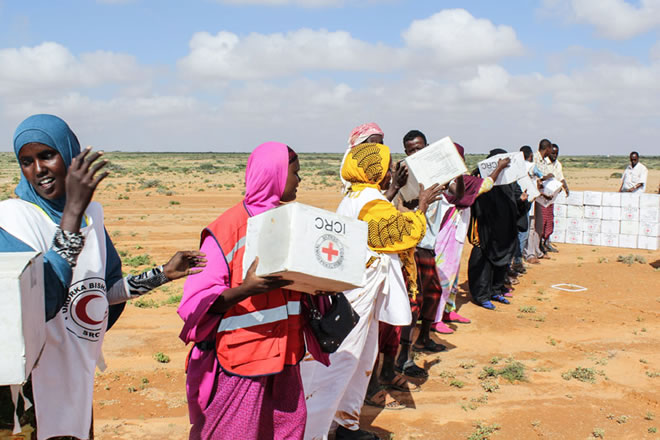
A sizeable population affected by a devastating cyclone in the north at the end of 2013 had already been struggling to recover their economic means before this most recent drought struck.CC BY-NC-ND / ICRC / so-e-00663/ F. RAbdullahi

Saturday, July 26, 2014
advertisements
Three years after the last severe food crisis that affected Somalia, rising numbers of the population are once again suffering acute problems and even more are at risk. Mohamed Sheikh Ali, who coordinates ICRC efforts to develop food production and relief efforts in the country describes the situation.Why is food insecurity increasing again in Somalia?
The answer is complex. There are a number of different factors that are contributing to a series of localised problems in both the centre and south of the country, but also in the far north of Somalia; but the populations worst affected are those suffering an overlap of climactic and conflict SHOCKS.
By climactic shocks you mean drought?
Not just, but yes – drought is part of the problem. Over the past few months, rains have been poor and erratic in some parts of South and Central Somalia, for instance in Beletweyn, Lower and Middle Jubas and areas of Lower and Middle Shabelle, as well as in areas of Puntland in the north. However, on top of this, a sizeable population affected by severe flooding in the south and a similar population hit by a devastating cyclone in the north at the end of 2013 had been struggling to recover their economic means already before this drought problem struck
But conflict has also contributed to the problem?
Somalis have been enduring perpetual conflict and absent or limited state services for the last 2 decades, leaving a large proportion of the population generally at high risk to such shocks. In the South and Centre, changes in the conflict situation and military clashes in 2014 have resulted in population displacement, as well as blockades of a number of towns, to which many have been moving. This has disrupted MARKETS, restricted trade and increased food prices in these urban centres. In the regions of Sool and Sanag in the north, recent political tensions and some insecurity have also led to population displacement.
Who is most at risk in this situation?
Whilst the combination of these different elements reduces productivity and income overall in these areas, those most at risk are the displaced populations, and in particular young children and pregnant and lactating mothers. Severe acute malnutrition rates amongst the Somali population were already amongst the highest in the world over many years, but the numbers facing acute problems are rising again in 2014.
What do you make of reports that the region may be facing a recurrence of El Nino?
El Nino is a cyclical climactic phenomenon whereby a warming of the Oceans results in drier-than-normal, and or wetter-than-normal conditions. Meteorologists are predicting a high likelihood of a strong El Nino hitting Somalia and the broader region later this year. Should this occur it would add a further layer of drought and/or flooding problems on top of those I already described, and result in a significantly elevated humanitarian crisis. However, this has not occurred yet. We are therefore monitoring these meteorological developments closely and preparing to respond in case this scenario does materialise.
Can we talk of risk of famine three years after the last severe food crisis as some aid agencies have warned?
In our view, there is no generalised famine in the country today. The situation at this stage is not what Somalia faced in the early 1990’s. However, that is little comfort to the growing population that are suffering severe FOOD SECURITY problems in the specific areas mentioned earlier. Their acute problems come on top of the chronic poverty and vulnerability severely affecting around 1 million Somalis resulting from the 20 years of conflict and climactic shocks. We are taking the situation of these people very seriously, and are concerned that the problem could worsen substantially later in the year.
What is the ICRC doing to help Somali to go through this difficult time?
It’s important to stress that we distribute emergency food only when needs are acute and urgent, as we did during the food crises drought in the 90’s and during the crisis of 2011-2012. Recently, more than 80’000 displaced people have received food in Beletweyne, and Sool and Sanaag, areas affected by conflict or insecurity. Otherwise, we support a stabilization centre in Kismayo, which has treated more than 900 children under 5 with severe acute malnutrition with complications since the beginning of 2014. In addition, our partners from the Somali Red Crescent Society run outpatient therapeutic feeding programs in 21 of their mobile and fixed clinics in South-Central Somalia with our support, which aim specifically at assisting malnourished young children and mothers.
Beyond these emergency activities, we also concentrate a large part of our efforts to support the recovery of economic self-sufficiency. We are for instance helping twenty agricultural cooperatives with agricultural inputs and tractors, five coastal communities with fishing material, and livestock authorities to resume the delivery of VETERINARY SERVICES . We consider of utmost importance to help Somalis to produce their own food and develop their capacities to overcome further food crises.